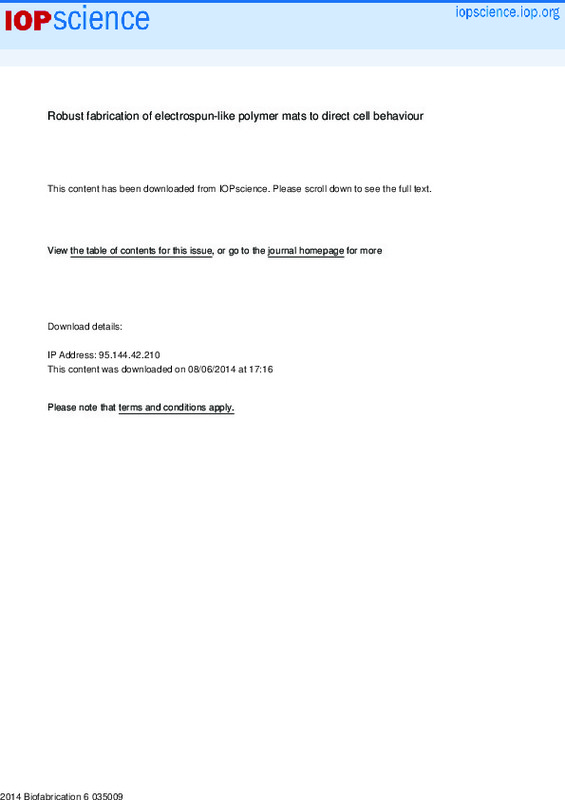JavaScript is disabled for your browser. Some features of this site may not work without it.
Buscar en RiuNet
Listar
Mi cuenta
Estadísticas
Ayuda RiuNet
Admin. UPV
Robust fabrication of electrospun-like polymer mats to direct cell behaviour
Mostrar el registro sencillo del ítem
Ficheros en el ítem
| dc.contributor.author | Ballester Beltrán, José
|
es_ES |
| dc.contributor.author | Lebourg., Myriam Madeleine
|
es_ES |
| dc.contributor.author | Capella Monsonís, Héctor
|
es_ES |
| dc.contributor.author | Díaz Lantada, Andrés
|
es_ES |
| dc.contributor.author | Salmerón Sánchez, Manuel
|
es_ES |
| dc.date.accessioned | 2016-04-06T11:33:38Z | |
| dc.date.available | 2016-04-06T11:33:38Z | |
| dc.date.issued | 2014-09 | |
| dc.identifier.issn | 1758-5082 | |
| dc.identifier.uri | http://hdl.handle.net/10251/62291 | |
| dc.description.abstract | Currently, cell culture systems that include nanoscale topography are widely used in order to provide cells additional cues closer to the in vivo environment, seeking to mimic the natural extracellular matrix. Electrospinning is one of the most common techniques to produce nanofiber mats. However, since many sensitive parameters play an important role in the process, a lack of reproducibility is a major drawback. Here we present a simple and robust methodology to prepare reproducible electrospun-like samples. It consists of a polydimethylsiloxane mold reproducing the fiber pattern to solvent-cast a polymer solution and obtain the final sample. To validate this methodology, poly( L-lactic) acid ( PLLA) samples were obtained and, after characterisation, bioactivity and ability to direct cell response were assessed. C2C12 myoblasts developed focal adhesions on the electrospun-like fibers and, when cultured under myogenic differentiation conditions, similar differentiation levels to electrospun PLLA fibers were obtained. | es_ES |
| dc.description.sponsorship | The support of ERC through HealInSynergy (306990) and FPU program AP2009-3626 is acknowledged. | en_EN |
| dc.language | Inglés | es_ES |
| dc.publisher | IOP Publishing: Hybrid Open Access | es_ES |
| dc.relation.ispartof | Biofabrication | es_ES |
| dc.rights | Reconocimiento (by) | es_ES |
| dc.subject | Biophysical cues | es_ES |
| dc.subject | Cell adhesion | es_ES |
| dc.subject | Microfabrication | es_ES |
| dc.subject | Cell alignment | es_ES |
| dc.subject | Electrospinning | es_ES |
| dc.subject | Myogenic differentiation | es_ES |
| dc.subject | Poly(lactic acid) | es_ES |
| dc.subject.classification | TERMODINAMICA APLICADA (UPV) | es_ES |
| dc.subject.classification | FISICA APLICADA | es_ES |
| dc.title | Robust fabrication of electrospun-like polymer mats to direct cell behaviour | es_ES |
| dc.type | Artículo | es_ES |
| dc.identifier.doi | 10.1088/1758-5082/6/3/035009 | |
| dc.relation.projectID | info:eu-repo/grantAgreement/ME//AP2009-3626/ES/AP2009-3626/ | es_ES |
| dc.relation.projectID | info:eu-repo/grantAgreement/EC/FP7/306990/EU/Material-driven Fibronectin Fibrillogenesis to Engineer Synergistic Growth Factor Microenvironments/ | en_EN |
| dc.rights.accessRights | Abierto | es_ES |
| dc.contributor.affiliation | Universitat Politècnica de València. Centro de Biomateriales e Ingeniería Tisular - Centre de Biomaterials i Enginyeria Tissular | es_ES |
| dc.contributor.affiliation | Universitat Politècnica de València. Departamento de Termodinámica Aplicada - Departament de Termodinàmica Aplicada | es_ES |
| dc.contributor.affiliation | Universitat Politècnica de València. Departamento de Física Aplicada - Departament de Física Aplicada | es_ES |
| dc.description.bibliographicCitation | Ballester Beltrán, J.; Lebourg., MM.; Capella Monsonís, H.; Díaz Lantada, A.; Salmerón Sánchez, M. (2014). Robust fabrication of electrospun-like polymer mats to direct cell behaviour. Biofabrication. 6(3). https://doi.org/10.1088/1758-5082/6/3/035009 | es_ES |
| dc.description.accrualMethod | S | es_ES |
| dc.relation.publisherversion | http://dx.doi.org/10.1088/1758-5082/6/3/035009 | es_ES |
| dc.type.version | info:eu-repo/semantics/publishedVersion | es_ES |
| dc.description.volume | 6 | es_ES |
| dc.description.issue | 3 | es_ES |
| dc.relation.senia | 278624 | es_ES |
| dc.identifier.eissn | 1758-5090 | |
| dc.contributor.funder | Ministerio de Educación | es_ES |
| dc.contributor.funder | European Commission |








